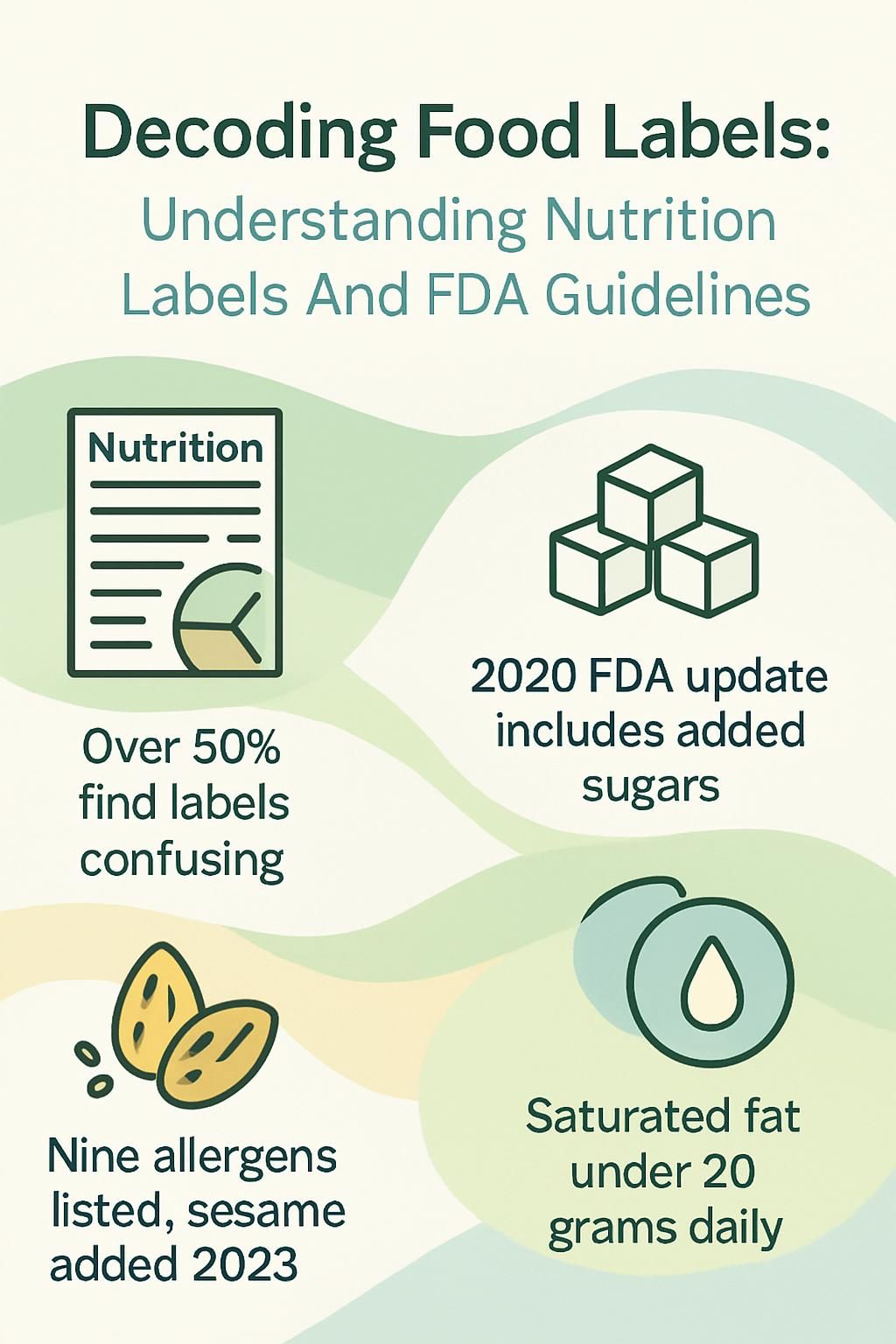Decoding Food Labels: Understanding Nutrition Labels And FDA Guidelines
Our Nutrition Assistant AI Suite will transform your body. You will lose fat, get toned, and build muscle. Gain confidence and optimal health.
Food shopping should not feel like a quiz. Yet many shoppers feel lost facing a food label and the nutrition facts label on a package. This guide breaks down what each part means so you can read food labels with confidence and use them to choose foods and beverages that fit your health goals.
Inside, you will learn how to read and understand serving size, calories, percent Daily Value, and the ingredient list. You will also see how FDA rules protect you through clear labeling, allergen notices, and updated daily values. Small label wins add up to better everyday choices.
Keep reading to learn simple steps for smarter, healthier decisions at the shelf.
Key Takeaways
- Most packaged foods must show serving size, calories, core nutrients, and major allergens under FDA rules. This improves clarity for shoppers.
- The 2020 FDA update added “Added Sugars,” adjusted serving sizes to reflect how people eat, and revised daily values for nutrients like fiber and sodium.
- Aim to limit saturated fat to about 20 grams per day, sodium to 2,300 milligrams, and added sugar to roughly 25 to 36 grams, based on national guidance.
- Labels must list nine major allergens, including sesame since 2023, and GMOs are disclosed as “bioengineered” under federal law effective 2022.
- Ingredients appear in order by weight. Use % Daily Value as a quick guide, about 5% DV is low and 20% DV is high, based on a 2,000 calorie reference diet.

What Are Nutrition Labels and Why Do They Matter?

Nutrition labels share the facts behind the package. They turn marketing claims into numbers you can compare.
What is a nutrition label and its purpose?
A nutrition label appears on most packaged foods and beverages. It lists serving size, calories, and amounts of fat, sodium, carbohydrate, added sugar, protein, vitamins, and minerals. You can use the nutrition facts label to see how much of each nutrient is in one serving. The Food and Drug Administration, under the Federal Food, Drug, and Cosmetic Act of 1938, requires these labels for transparency and consistency.
Labels also show ingredients in order by weight, from the most to the least. This helps you spot what the food contains in the largest amounts. With these details, you can compare products quickly and choose options that support a healthy diet.
The nutrition facts label is your tool for making informed choices about the foods and beverages you eat every day.
Knowing how to use this tool makes each grocery trip easier and smarter.
Why are nutrition labels important for consumers?
Labels let you check grams of saturated fat, added sugar, sodium, and dietary fiber per serving. Calorie counts help with weight management and meal planning. Percent Daily Value, or %DV, shows how much a serving contributes to a typical 2,000 calorie day. A low %DV is 5% or less. A high %DV is 20% or more.
Allergen labeling helps people avoid harmful ingredients such as milk, eggs, fish, tree nuts, peanuts, wheat, soy, shellfish, and sesame. You can also compare foods for nutrients many people need more of, like potassium, calcium, iron, and vitamin D. Clear labels mean better choices for you and your family. Sources: FDA Labeling Rules; Dietary Guidelines for Americans.
Key Components of Nutrition Labels
Think of the label as a dashboard. Each section tells part of the story.
What does serving size and servings per container mean?
Serving size is the typical amount people eat or drink at one time. It appears in familiar units, such as cups, ounces, or pieces, along with grams. This standard lets you compare foods fairly. Servings per container tells you how many servings are in the whole package.
If a can lists two servings and each serving has 100 calories, eating the whole can means 200 calories. Many small packages hold more than one serving. Checking both lines helps you manage portions and energy intake.
How to understand total calorie information?
“Calories” at the top of the label shows the energy in one serving. The label also lists servings per container. If you eat more than one serving, multiply the calories accordingly. Small packages can be misleading if you assume they are single serving.
Keep an eye on packages that show calories for both a single serving and the entire container. This feature makes it easier to gauge your true intake. It is a simple habit that supports weight management and balanced eating.
Checking total calories helps prevent overeating and supports healthy weight management.
Once calories are clear, scan the nutrients that should be limited.
Which nutrients should be limited on labels?
Limit saturated fat, trans fat, added sugars, and sodium. High intake of these nutrients raises the risk of high blood pressure, heart disease, obesity, and type 2 diabetes. Many health groups suggest about 20 grams of saturated fat or less per day on a 2,000 calorie diet. Keep trans fat as low as possible. Added sugar goals are about 25 grams per day for women and 36 grams for men, based on American Heart Association guidance. Sodium should stay under 2,300 milligrams daily.
Check labels for words like sucrose, high fructose corn syrup, glucose syrup, or honey. These signal added sugars. For sodium, compare brands of the same food to find lower options. Small changes add up across the day.
What are the important beneficial nutrients to look for?
Focus on fiber, vitamins, and minerals. Fiber supports digestion and steadier blood sugar. Many adults fall short of daily targets, about 25 grams for women and 38 grams for men. Look for vitamin D, calcium, potassium, and iron, since they are often underconsumed.
Protein supports muscles and energy. Beans, eggs, dairy, lean meats, fish, and nuts are common sources. Fruits add vitamin C, and leafy greens provide folate and magnesium. Use %DV to see how each serving helps meet your daily needs without excess added sugar or unhealthy fats.
How is Percent Daily Value (%DV) calculated and used?
%DV shows how much a serving contributes to a typical daily intake on a 2,000 calorie reference diet. For instance, 10% DV sodium means that serving provides 10% of the daily limit for a 2,000 calorie plan. As a quick rule, 5% DV or less is low, and 20% DV or more is high.
Use %DV to compare similar foods and pick options higher in fiber, vitamin D, calcium, iron, and potassium, and lower in saturated fat, added sugars, and sodium. It is a fast way to align choices with your goals.
FDA Nutrition Labeling Requirements
Regulations set the guardrails so labels mean the same thing across brands.
What are the mandatory labeling rules by the FDA?
- Each packaged food must show a Nutrition Facts label with serving size, servings per container, calories, and required nutrients such as fat, sodium, carbohydrate, sugar, and protein.
- All ingredients must be listed in descending order by weight. This helps you find additives and assess the ingredient list at a glance.
- Major allergens, including milk, eggs, fish, shellfish, tree nuts, peanuts, wheat, soy, and sesame, must appear in the ingredient list or in a clear “Contains” statement.
- % Daily Value must be displayed for key nutrients to help quick comparisons across products.
- “Added Sugars” must be listed to help you control intake of sweeteners.
- Terms such as “gluten-free,” “organic,” “fortified,” “enriched,” “light,” and “lite” follow strict definitions.
- Meat and poultry labels are overseen by USDA but follow similar transparency goals at retail.
- Manufacturers provide contact details for questions or feedback about labels and products.
These rules make it easier to learn how to read labels and choose foods that match your diet plan.
What recent changes have been made to label regulations?
The FDA modernized the Nutrition Facts label in 2020. Changes include listing Added Sugars, updating serving sizes to reflect how people actually eat, and revising daily values for several nutrients. Larger packages often show both calories per serving and calories per container. The updates reflect current science and typical eating patterns (FDA, 2020).
For example, one serving of soda is now listed as 12 ounces, not 8 ounces. With clearer numbers, it becomes faster to spot lower sugar, lower sodium choices that fit your needs.
What Do Common Food Label Terms Mean?
Labels use short terms to pack in a lot of meaning. Here is how to decode them.
What are added sugars on labels?
Added sugars are sweeteners put into foods during processing or preparation. Examples include table sugar, honey, syrups, and concentrated fruit juices. On the label, “Added Sugars” appears under total sugars. This line makes it easier to limit extra calories from sweeteners and reduce the risk of weight gain and type 2 diabetes.
Compare similar foods side by side. Many sauces, dressings, and cereals vary widely in added sugar. Picking a lower number is a simple way to cut daily sugar without changing your meal plan.
What does fortified or enriched mean?
Fortified means nutrients were added that were not originally there. Enriched means nutrients lost during processing were added back. Many breakfast cereals are fortified with vitamin D, B vitamins, and iron. White flour is commonly enriched with iron and B vitamins like niacin, thiamin, and riboflavin.
If you have allergies, read labels closely. Added nutrients can come from milk, soy, or other sources. Fortified or enriched foods can help close nutrient gaps when your usual diet falls short.
How is gluten-free defined on labels?
“Gluten-free” foods must contain less than 20 parts per million of gluten. They cannot include wheat, rye, barley, or crossbred grains like triticale. Manufacturers must prevent cross-contact during production and packaging to use the claim (FDA).
Gluten-free labeling helps people with celiac disease or gluten sensitivity find safe options with confidence.
What should you know about organic product labels?
The USDA Organic seal means at least 95% of ingredients are certified organic. These standards limit most synthetic pesticides, fertilizers, and genetically modified organisms. Items labeled “made with organic ingredients” contain at least 70% organic ingredients but cannot use the USDA seal.
Organic does not always mean lower sugar or sodium. Always review both the nutrition label and the ingredient list for the full picture.
What does light or lite indicate on a label?
“Light” or “lite” usually signals fewer calories or less fat than the regular version. Under FDA rules, light items must have either one third fewer calories or half the fat per serving compared to the standard product. Some light products also lower sodium.
Read the panel to see what changed, calories, fat, or sodium. Then compare brands to find the option that best supports your goals.
Why Is Serving Size Important on Nutrition Labels?
Serving size is the scale on your map, it tells you how to read the rest.
How is serving size determined?
Serving sizes are based on what people typically eat at one time. The FDA uses national food surveys such as NHANES to set these amounts. The goal is to reflect real habits so labels are useful for comparison.
A serving rarely equals the entire package. A snack bag might list three servings even if it looks like one. Check the label so you can align portions with your daily plan.
How does serving size affect calorie and nutrient values?
All numbers on the label refer to one serving. If you eat two servings, you double calories and every nutrient listed. That includes saturated fat, added sugars, and sodium.
As a quick check, compare the portion you plan to eat with the serving size printed on the panel. Adjust your math to see the true impact on your day.
How Do Calories Relate to Your Daily Dietary Needs?
Calories are your energy budget. Spend them on foods that give nutrients back.
How do you read calorie information on labels?
- Find “Calories” near the top of the Nutrition Facts label, just below serving size.
- Know that the calories listed are for one serving, unless the package states “per container.”
- Match the serving size to what you will eat. Two servings means twice the calories.
- Look for packages that list calories per container to avoid portion errors.
- Use the 2,000 calorie reference as a general guide unless your needs differ.
- Watch multi-serving snacks and drinks, they can add many calories fast.
- Use calories alongside nutrients to choose foods that fit your health goals.
How can calorie info be tailored to individual diets?
Calorie needs vary by age, sex, body size, activity, and health goals. Children may need about 1,600 calories a day, while active teens can need 3,000 or more. Many adults fall between 1,800 and 2,400 calories. The %DV on labels is based on a 2,000 calorie reference diet.
Check serving size and calories per serving for each food. Adjust portions to meet your target. For weight loss, choose lower calorie items and smaller portions. For athletes, pick nutrient dense foods with enough energy to support training.
How to Identify and Limit Unhealthy Nutrients?
Spot the red flags first, then compare smarter options side by side.
How to spot high levels of fat, sugar, and sodium?
- Check total fat, added sugars, and sodium per serving in grams or milligrams.
- Use %DV as a quick flag. Around 20% DV or more per serving is high.
- Look for saturated fat, trans fat, added sugars, and sodium near the top of the panel.
- Scan the ingredient list for hydrogenated oils, high fructose corn syrup, glucose syrup, or monosodium glutamate.
- Be cautious with processed foods that push sodium near the daily limit or added sugar above 10 grams per serving.
- Compare similar products. Differences in sugar or sodium can be twofold across brands.
Swapping a cereal from 18 grams of added sugar to 6 grams per serving can cut hundreds of calories a week.
What health risks come from consuming too much?
Too much saturated and trans fat raises LDL cholesterol and the risk of heart disease. High sodium consumption increases blood pressure, which strains the heart and kidneys. Excess added sugar links to weight gain, type 2 diabetes, and tooth decay. Many people consume over 3,400 milligrams of sodium per day, well above the 2,300 milligram limit recommended by health authorities like the CDC.
Choosing lower numbers on the panel can help reduce the risk of chronic disease. Small shifts across meals make a measurable difference over time.
Why Should You Focus on Beneficial Nutrients?
Filling your plate with nutrients your body needs is the simplest upgrade.
What are the health benefits of fiber, vitamins, and minerals?
Fiber supports regular digestion and can help lower cholesterol. It also increases fullness so you are less likely to overeat. Vitamins and minerals power many body systems. Vitamin C supports immunity and improves iron absorption. Calcium and vitamin D strengthen bones. Potassium helps manage blood pressure.
Choosing foods rich in these nutrients brings steady energy and long term health benefits. Aim for nutrient dense choices at each meal.
How do these nutrients support overall health?
Vitamins A, C, and D support your immune system and healing. Minerals like calcium build strong bones, and iron helps blood carry oxygen. Fiber lowers the risk of heart disease and helps control blood sugar. Potassium counters sodium to support normal blood pressure.
Balanced intake of these nutrients reduces gaps in your diet and supports a healthier life.
How to Analyze Ingredient Lists on Food Labels?
The ingredient list tells the story behind the numbers on the panel.
What does the order of ingredients tell you?
Ingredients are listed from the largest amount to the smallest by weight. The first items make up most of the food. If sugar shows up first, sugar is a major ingredient. If whole grain oats appear near the top, there is a meaningful amount of oats.
Items like salt or flavorings usually appear near the end and are present in smaller amounts. This order helps you spot foods that rely on added sugars or refined oils.
How to find hidden additives and allergens?
- Read the full ingredient list, not just the front of the package.
- Learn other names for top allergens, such as casein for milk or albumin for egg.
- Watch for “Contains,” “May contain,” or “Processed in a facility with,” which warn about cross-contact.
- Look for artificial colors, flavors, preservatives like BHT or sodium benzoate, and sweeteners like sucralose.
- Review FDA guidance for the nine major allergens, including sesame.
- Search unfamiliar ingredients using the FDA’s Food Additive Status List.
- Know that organic foods can still include approved additives. Check each ingredient if you follow a strict diet.
- Notice bold type or other formatting that highlights allergens as required by law.
- For severe allergies, contact the manufacturer for details about production practices.
Use these steps to reduce unwanted exposure to additives and allergens and to shop with confidence.
How Are Labels Used for Dietary Preferences?
Clear labels help match products to your needs, from allergies to GMO views.
What are the allergen labeling requirements?
Federal law requires clear labeling of milk, eggs, fish, shellfish, tree nuts, peanuts, wheat, soybeans, and sesame. These allergens must be named in the ingredient list or in a “Contains” statement. The Food Allergen Labeling and Consumer Protection Act started in 2006, and sesame became the ninth major allergen in 2023.
Advisory statements like “may contain” or “processed in a facility with” can also appear. Sensitive individuals should take these seriously since even tiny amounts can trigger reactions.
What are the rules for GMO labeling?
The National Bioengineered Food Disclosure Standard requires disclosure of bioengineered ingredients. Packages may use text, a symbol, an electronic code, or a digital link to share this information. The standard took effect in January 2022 for retail products in the United States.
Some companies also use third party “Non-GMO” certifications. These programs have their own verification steps. Reviewing disclosures helps you choose foods that match your preferences.
How Can You Make Informed Food Choices Using Labels?
Use labels like a checklist, then pick the option that best fits your plan.
How to compare similar products effectively?
- Match serving sizes first. Different serving sizes make fair comparison impossible.
- Compare calories per serving for snacks and drinks that vary widely.
- Choose lower saturated fat, added sugars, and sodium when possible.
- Look for higher protein and fiber to support fullness and steady energy.
- Check %DV for calcium, iron, potassium, and vitamin D to find nutrient dense picks.
- Scan ingredients for whole foods and shorter lists with fewer artificial additives.
- Confirm allergen information if you have sensitivities.
These quick checks make it easy to pick the right product without slowing down your trip.
How to use labels for balanced diet planning?
- Start with serving size and servings per container for accurate portion tracking.
- Use calorie counts to meet your energy target, often around 2,000 calories for adults.
- Pick higher %DV for fiber and key vitamins and minerals, and lower %DV for saturated fat, added sugars, and sodium.
- Check ingredient lists to spot hidden sugars and refined oils.
- Favor whole grain and high fiber options or foods fortified with needed nutrients.
- Compare similar items and choose the one with less sodium or added sugar.
- Use “organic” or “gluten-free” claims only if they match your diet needs.
- Monitor total fat grams per serving to stay within healthy ranges.
- Adjust home portions using label data so you do not exceed daily targets.
- Plan a shopping list after reviewing labels to support a balanced weekly menu.
These steps turn the panel into a simple planning tool for you and your family.
What Are Common Misconceptions About Nutrition Labels?
Labels are helpful, but a few quirks can trip you up if you rush.
How can serving sizes be misleading?
Serving sizes can be smaller than what people pour or plate. If the label lists 12 chips as a serving and you eat three times that amount, your calories, fat, and sodium triple. Some bottles list more than one serving even though they look single serve.
Always compare your portion to the serving size on the panel. Do the quick math to see what you are actually eating.
What are frequent mistakes interpreting %DV?
People often treat %DV as a one size fits all guide. It is based on a 2,000 calorie reference diet, which may not match your needs. Active teens or adults may need more energy and nutrients. Older adults may need less.
Another mistake is ignoring serving size while using %DV. Two servings double the %DV you consume. Pair %DV with ingredients and portion size for the full picture.
What Resources Help You Understand Nutrition Labels Better?
Simple tools and trusted guides make learning the label fast and practical.
What interactive tools are available for nutrition labels?
The FDA provides an online Nutrition Label Interactive that explains each part of the panel. Popular mobile apps, such as Fooducate and MyFitnessPal, scan barcodes, show nutrition information, and compare products in seconds. Many grocery sites let you filter items by “low sodium,” “high fiber,” or other nutrient targets.
These tools help you check serving size, percent Daily Value, and calories per serving while you shop.
Where to find educational materials from the FDA?
Visit www.fda.gov and open the Food section. You will find fact sheets, videos, printable guides, and youth materials on how to use the nutrition facts label. The Labeling and Nutrition pages explain daily values, serving sizes, ingredient lists, and recent rule changes.
These free resources are handy for families, classrooms, and community programs that teach healthy eating skills.
How Do Nutrition Labels Impact Healthy Eating Habits?
Knowledge shapes habits. Labels turn guesswork into simple, daily choices.
How do labels support informed food choices?
Labels help you compare calories, saturated fat, added sugars, sodium, fiber, vitamins, and minerals. %DV shows if a serving has a little or a lot of a nutrient. Serving size helps with portion control. Ingredient lists allow you to avoid allergens and spot ultra processed ingredients.
Because FDA rules standardize panels across brands, the same skills work in every aisle. It becomes easier to plan meals and manage your day.
How do they help reduce diet-related health risks?
Using labels to limit saturated fat, added sugars, and sodium can lower the risk of obesity, high blood pressure, heart disease, and type 2 diabetes. Choosing foods higher in fiber, calcium, vitamin D, potassium, and iron supports gut health, bone strength, and healthy blood pressure.
Small label-based swaps, like lower sodium soup or yogurt with less added sugar, can improve health markers within weeks. Source: CDC; FDA.
Conclusion
Understanding food labels, the nutrition facts label, and FDA guidelines gives you practical control over daily eating. Check serving size, calories, %DV, and the ingredient list to compare foods quickly and choose products that fit your plan.
Use labels to limit saturated fat, added sugar, and sodium, and to find foods rich in fiber, vitamins, and minerals. With a few simple checks, you can build a balanced diet that supports long term health. For personal nutrition advice, consult a registered dietitian or your healthcare provider.
Health information in this article is for education only and is not a substitute for professional medical advice.
FAQs
1. What information must appear on nutrition labels according to FDA guidelines?
Nutrition labels must list serving size, calories, total fat, saturated fat, trans fat, cholesterol, sodium, total carbohydrates, dietary fiber, total sugars, added sugars, protein, vitamin D, calcium, iron, and potassium. The FDA requires this information to help consumers make informed food choices. A 2020 FDA report found that over 80 percent of packaged foods now meet these requirements.
2. How do serving sizes on food labels help consumers?
Serving sizes reflect the amount people usually eat or drink. This helps consumers compare similar foods and manage portion control. For example, a cereal box may list a serving as one cup, making it easier to track calories and nutrients. In my experience, checking serving sizes helped me avoid overeating snacks by measuring out portions.
3. Why is it important to understand daily value percentages on nutrition labels?
Daily value percentages show how much a nutrient in one serving contributes to a daily diet based on 2,000 calories. This helps consumers see if a food is high or low in a specific nutrient. For instance, a food with 20 percent daily value of calcium is a good source. The FDA suggests using these percentages to balance nutrient intake throughout the day.
4. How can reading food labels support healthier eating habits?
Reading food labels allows consumers to compare products and choose options lower in sodium, added sugars, or saturated fat. Data from the Centers for Disease Control and Prevention show that people who read labels tend to eat more fruits, vegetables, and whole grains. Reviewing labels has helped me select foods with less sugar for my family’s meals.
Summary: Nutrition labels provide key facts about serving size, nutrients, and daily values as required by FDA guidelines. Understanding these details supports better food choices and healthier eating patterns.







